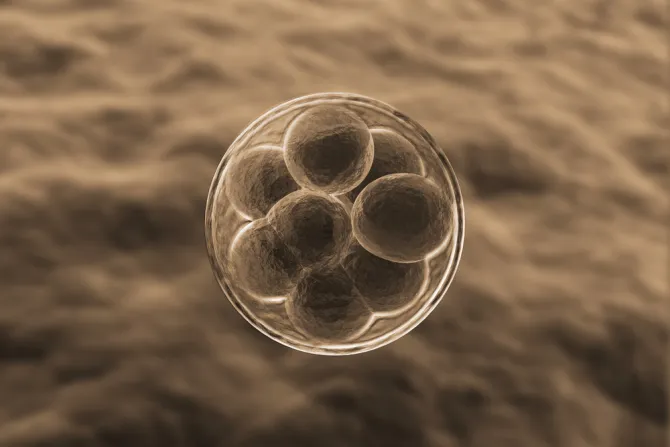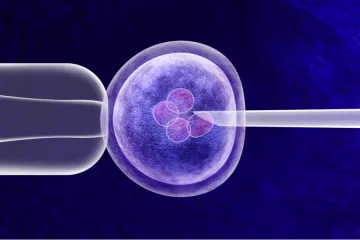Denver, Colo., May 11, 2023 / 14:50 pm
Catholic ethicists greeted the news that the first U.K. baby has been born after being conceived via a “three-parent” embryo modification technique with caution and strong criticism.
Though these experts welcomed the birth of the baby, they warned that the new technique destroys other newly conceived embryos in the process of inserting healthy genetic material to address a genetic flaw in a mother’s eggs.
“This is the destruction of two embryonic human individuals to create a third individual,” the Anscombe Bioethics Centre said May 10. “This is primarily unethical due to the destruction of two unique innocent human beings, who had inherent dignity and rights.”
The Oxford-based Catholic bioethics research center challenged the technique on other grounds, including the “fracturing of biological parenthood” and the potential for “serious unintended consequences.”
The U.K.’s Human Fertilisation and Embryology Authority (HFEA) disclosed to The Guardian that, as of late April, “less than five” babies had been born after being conceived through the new technique. This involves the in-vitro fertilization of several embryos and their modification through a process called mitochondrial donation treatment or mitochondrial replacement therapy.
The process aims to eliminate mitochondrial disease, in which a woman’s eggs have faulty mitochondria. These cellular structures, inherited only from the mother, normally convert food into energy that the body can use. Diseased mitochondria can lead to brain damage, muscle wasting, heart failure, and blindness.
The HFEA has approved at least 30 conception attempts through the new technique. The Newcastle Fertility Clinic at Life, under the Newcastle Hospitals NHS Foundation Trust, is the only clinic approved to attempt the process under the provisions of a 2015 U.K. law.
Though the child resulting from this technique is sometimes called a “three-parent baby,” more than 99.8% of the genetic material comes from the baby’s mother and father, and the rest from an egg donor’s mitochondria, according to The Guardian.
The Anscombe Bioethics Centre explained the specific pro-nuclear transfer technique used in the modification process. Researchers used the sperm of the intended father to fertilize a woman’s egg that had faulty mitochondria. This created “one new embryonic human individual,” albeit with faulty mitochondria.
Researchers then fertilized an egg from a woman with healthy mitochondria “to create another new embryonic human individual” who has healthy mitochondria. They then removed the nuclear material, contained in two cellular structures called pronuclei, from the second embryo and replaced it with the nuclear material from the first.
This creates “a third embryonic human being who has the nuclear DNA of the father and of one mother, but the rest of the embryo, including the mitochondria, from the egg donor mother,” the Anscombe Bioethics Centre said.
The phrasing “mitochondrial donation” is misleading, the bioethics center maintained. Mitochondria are not being donated like organs. Rather, it is “a form of cell nuclear transfer” in which the first two embryos are “functionally destroyed by the removal of their pronuclei, and parts of both used to create a third embryonic human.”
“Human life is treated as a commodity, with only the ‘unflawed’ human beings allowed to live,” Marie Hilliard, a senior fellow at the U.S.-based National Catholic Bioethics Center, told CNA. “Numerous embryos are engendered and only the desired embryos given the sustenance of the womb, befitting of our human dignity and enabling life to flourish.”
Hilliard, a nurse educator and former state health care regulator with a master’s degree in maternal child health nursing, as well as canon law, noted the egg donor’s own child is “engendered and destroyed” in the process, which she characterized as “an abuse of that donor, regardless of the perceived ‘good.’” Egg donation poses health risks to the donor, typically a young woman. Possible side effects of ovarian hyper-stimulation drugs include polycystic ovary disease, which can lead to infertility.
David Albert Jones, director of the Anscombe Bioethics Centre, reflected on the news that a baby had been born as a result of the technique.
“Every child newly conceived is to be welcomed and we hope this new human life brings joy to his or her parents, but some way of conceiving children involve risks or harms to the child,” said Jones, who is a bioethics professor at St. Mary’s University, Twickenham. “This is a new and unnecessary technique that does not add to the safety of IVF involving an egg donor but adds further risks.”
(Story continues below)
The Anscombe Bioethics Centre voiced concern that the new baby will lack any sure knowledge of the egg donor’s identity. The center characterized the transfer of nuclear DNA as “a form of genetic engineering which affects the human germline” and so any changes will be inherited by future generations. The bioethics center warned of unforeseen consequences in the relationship between the transplanted cell nucleus and the mitochondria. The interaction of the mitochondrial genome and the nuclear genome has “pervasive effects on cellular and organismal functioning,” the center said.
Dagan Wells, a professor of reproductive genetics at the University of Oxford, took part in the research. Wells told The Guardian that the risks of the procedure include “reversion.” This is when a small number of diseased or abnormal mitochondria are carried over from the original embryo into the final embryo. This can still lead to mitochondrial disease.
For Wells, the clinical experience with mitochondrial replacement therapy has been “encouraging” but not enough is yet known to reach conclusions about the process’ safety or efficacy.
“Long-term follow-up of the children born is essential,” Wells told The Guardian. Academic publications on the process have been submitted for peer review.
In Hilliard’s understanding, the technique used in the U.K. is currently illegal in the U.S.
“However, numerous other in vitro engendering and manipulating of human life methods continue, ultimately denying life to the less ‘perfect’ embryo. Again, this is an assault on all of humanity,” she told CNA.
“Such manipulation of human life should be prohibited,” she said. In her view, there is a “significant need” for animal research that does not destroy human beings at their most vulnerable stage of life. She also pointed to advances in gene therapy as another promising path for ethical research.
The U.K. baby is not the first to be born using an IVF/mitochondrial donation treatment. In 2016, a U.S.-based medical team announced the birth of a boy who was born after they implanted a modified embryo into a Jordanian woman’s womb in Mexico to avoid a U.S. ban. The embryo modification drew serious criticism and the medical team still ran afoul of American regulators because the embryo had been modified in the U.S. and then exported to Mexico.
The U.S. Food and Drug Administration bans this form of embryo modification as illegal “human subject research.” As of 2018, the boy appeared to be free of mitochondrial disease, the Washington Post reported.





